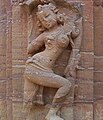Salabhanjika
The term Salabhanjika , derived from ancient Indian Sanskrit , describes a female figure who - literally - breaks off branches from a sal tree . You can find them in the Buddhist , Jainist and Hindu art of the Indian cultural area. Sometimes these figures are also interpreted as "tree nymphs"; Depending on the region and language, they are also known under the names madanakai , madanika or shilabalika .
presentation

The figure-accentuating representation of the Salabhanjikas brings them closer to the “beautiful girls” ( surasundaris ), but in contrast to these they are always represented individually or in isolation. One of her arms is raised and reaches into the branches or foliage of a sal tree or an Ashoka tree ; In early Buddhist art, she sometimes also holds the tree trunk with one leg - a motif that is meant to be erotic. Salabhanjikas are more earthly creatures with only two arms and no typical attributes; their erotic charisma is based primarily on their figure-hugging posture ( tribhanga ). In later Hindu art they are mostly depicted dancing, but in a lush tree-lined setting.
Because of their posture, which connects in some way heaven and earth, can be found salabhanjika preferably as Konsolfiguren (ger .: bracket figures ) to the free-standing gate buildings ( toranas ) Buddhist stupas (z. B. Sanchi ) or in the central dance hall ( maha mandapa ) of a temple (e.g. Belur or Khajuraho ). Famous all over India is the torso of a salabhanjika from Gyaraspur , which is now kept in the Archaeological Museum of Gwalior (photo see web link).
meaning
Their closeness to nature brings the Salabhanjikas in connection with the forest deities ( yakshis ) that are widespread in popular belief , but - unlike these - they are clearly beautiful and positively charged figures with a certain proximity to rural fertility cults. In this context it is worth noting that Maya , the mother of the Buddha , gave birth to her son standing - holding on to the branches of a sal tree or an Ashoka tree with one hand.
Comparable to the “heavenly lovers” ( mithunas ), the salabhanjikas and surasundaris also have an apotropaic meaning: in the presence of beauty and eroticism, evil forces lose their power.
photos
Console figure of a dancing salabhanjika in the Chennakesava Temple , Belur
dancing salabhanjika at Mukteswar Temple , Bhubaneshwar
salabhanjika at Rajarani temple , Bhubaneswar
salabhanjika from Sanchi
Salabhanjika as a lady playing the drum ( dollu kunitha ) in the Chennakesava Temple , Belur
literature
- Gauri Parimoo Krishnan: The Power of the Female. Devangana Sculptures on Indian Temple Architecture. DK Printworld, New Delhi 2014, ISBN 978-8124606872 .
- Eckard Schleberger: The Indian gods. Shape, expression and symbol. A handbook of Hindu iconography. Diederichs, Cologne 1997, ISBN 978-3-424-00898-2 .
- Hans Wolfgang Schumann: Buddhist world of images. An iconographic handbook of Mahayana and Tantrayana Buddhism. Eugen Diederichs Verlag, Cologne 1998 ISBN 978-3-424-00897-5 .






